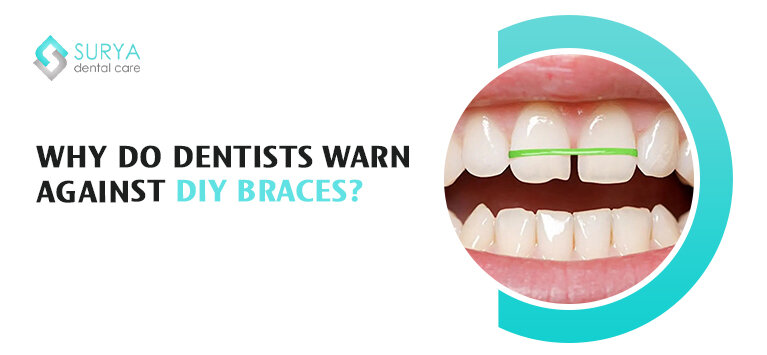
If you watch YouTube videos frequently, you might come across instructional videos on how to make teeth-straightening braces. As plenty of DIY braces videos are available on youtube, many youngsters prefer this way to straighten their teeth. The trend of wearing DIY braces is on the constant rise.
Such do-it-yourself braces need to meet the level of quality provided by dentists. Likely, at-home teeth straightening appliances are not a safer option, as YouTubers proclaim.
Those who advocate DIY braces are unaware of the dental damage the appliance causes. Please keep reading to know more about its detrimental impacts.
How do people create braces on their own?
The DIY braces are fabricated with household items such as
- Rubber bands
- Fishing line
- Hair elastics
- Earring backs
- Superglue
- Paper clips
- Dental floss wire
It is instructed to wrap the elastic band around a tooth to make it move. The YouTubers mention that the braces made at home would cause some discomfort initially, but this discomfort would eventually go away.
We want to remind those vloggers such dental appliances prepared with no professional support can lead to various irreversible damages.
Why using homemade braces is a bad idea?
Dental doctors and Orthodontists are against the idea of at-home teeth straightening kits and DIY braces due to the following reasons:
1) It is not an effective solution
Orthodontic treatments are just more than straightening your teeth. Wearing dental braces tends to move teeth into the correct position and reposition the jawline. Typically, the braces take pressure off the jaw while aligning teeth to avert lower and upper teeth from rubbing against one another.
You cannot expect it in DIY braces. If the teeth clench together during the straightening process, it will lead to unforeseen repercussions like dental fractures, teeth cracks, and even teeth loss.
2) They introduce harmful microbes into the mouth
If you look at the components of DIY braces, they are gadgets for daily and certain household activities. Aside from their chemical constituents, tiny microorganisms are also present on their surfaces. It implies that those brace wearers pave the way for hazardous substances and microorganisms to enter their mouths. In simply, it increases the risk of infection.
3) Gum damage
DIY braces’ parts are sharp and unhygienic so they can damage the enamel. Likely, they cut the oral tissues, causing cuts or bruises on lips, cheek, gums, tongue, etc.
The DIY braces’ components might sometimes trap between the teeth and gums. In such circumstances, the gum tissues undergo frequent irritations from the alien substance. Additionally, it hinders healing, leading to increased bacteria behind the gums. In the end, it gives rise to severe gum infectious conditions like periodontitis and gum recession.
4) Root Resorption
When a brace component lodges between the teeth and gums, it will also affect the teeth roots. The trapped substance will interrupt the blood flow to a tooth. It prevents the tooth’s supporting bone from receiving enough nutrients from the blood flow.
If it is not treated right away, the tissues surrounding the tooth begin to be absorbed by our body, weakening the bone. It ends in tooth loss.
Bottom line
The braces made at home, at-home teeth straightening kits, and even 3D braces provided by teledentistry companies cannot replace the braces orthodontic doctors give. It is because the teeth braces an orthodontist provides have clear, lightweight brackets and components that do not hurt your teeth and oral tissues. Likely, the treatment plan is created, and the proper type of brace is chosen after considering criteria like the degree of crowding, etc. Such preparation requires an expert’s support.
You’re mistaken if you believe DIY braces are reliable and secure, as many well-known vloggers talk about. Please rethink what you believe about it.



